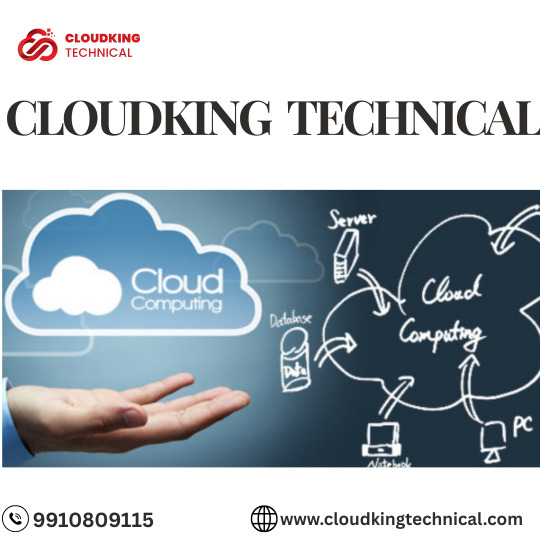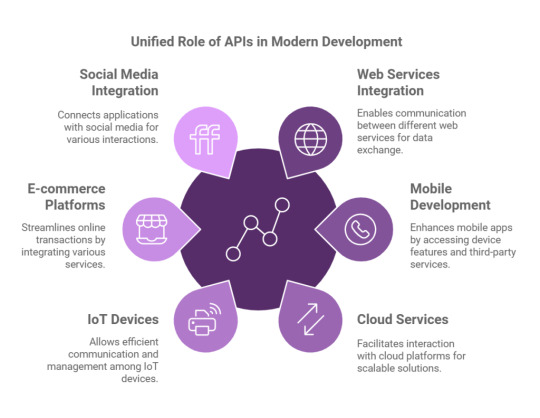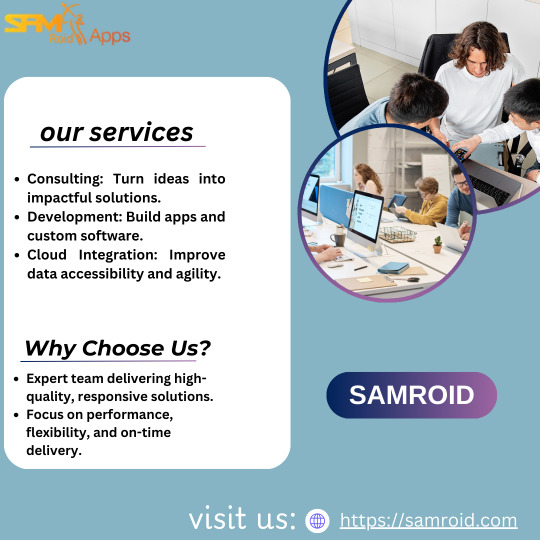#CloudIntegration
Explore tagged Tumblr posts
Text
Cloud Migration and Integration A Strategic Shift Toward Scalable Infrastructure
In today’s digital-first business environment, cloud computing is no longer just a technology trend—it’s a foundational element of enterprise strategy. As organizations seek greater agility, scalability, and cost-efficiency, cloud migration and integration have emerged as critical initiatives. However, transitioning to the cloud is far from a lift-and-shift process; it requires thoughtful planning, seamless integration, and a clear understanding of long-term business objectives.

What is Cloud Migration and Why Does It Matter
Cloud migration involves moving data, applications, and IT processes from on-premises infrastructure or legacy systems to cloud-based environments. These environments can be public, private, or hybrid, depending on the organization’s needs. While the move offers benefits such as cost reduction, improved performance, and on-demand scalability, the true value lies in enabling innovation through flexible technology infrastructure.
But migration is only the first step. Cloud integration—the process of configuring applications and systems to work cohesively within the cloud—is equally essential. Without integration, businesses may face operational silos, inconsistent data flows, and reduced productivity, undermining the very purpose of migration.
Key Considerations in Cloud Migration
A successful cloud migration depends on more than just transferring workloads. It involves analyzing current infrastructure, defining the desired end state, and selecting the right cloud model and service providers. Critical factors include:
Application suitability: Not all applications are cloud-ready. Some legacy systems may need reengineering or replacement.
Data governance: Moving sensitive data to the cloud demands a strong focus on compliance, encryption, and access controls.
Downtime management: Minimizing disruption during the migration process is essential for business continuity.
Security architecture: Ensuring that cloud environments are resilient against threats is a non-negotiable part of migration planning.
Integration for a Unified Ecosystem
Once in the cloud, seamless integration becomes the linchpin for realizing operational efficiency. Organizations must ensure that their applications, databases, and platforms communicate efficiently in real time. This includes integrating APIs, aligning with enterprise resource planning (ERP) systems, and enabling data exchange across multiple cloud platforms.
Hybrid and Multi-Cloud Strategies
Cloud strategies have evolved beyond single-provider solutions. Many organizations now adopt hybrid (combining on-premise and cloud infrastructure) or multi-cloud (using services from multiple cloud providers) approaches. While this enhances flexibility and avoids vendor lock-in, it adds complexity to integration and governance.
To address this, organizations need a unified approach to infrastructure orchestration, monitoring, and automation. Strong integration frameworks and middleware platforms become essential in stitching together a cohesive IT ecosystem.
Long-Term Value of Cloud Transformation
Cloud migration and integration are not one-time projects—they are ongoing transformations. As business needs evolve, cloud infrastructure must adapt through continuous optimization, cost management, and performance tuning.
Moreover, integrated cloud environments serve as the foundation for emerging technologies like artificial intelligence, data analytics, and Internet of Things (IoT), enabling businesses to innovate faster and more efficiently.
By treating cloud migration and integration as strategic investments rather than tactical moves, organizations position themselves to stay competitive, agile, and future-ready.
#CloudMigration#CloudIntegration#DigitalTransformation#HybridCloud#MultiCloud#CloudComputing#InfrastructureModernization#ITStrategy#BusinessContinuity
2 notes
·
View notes
Text
#MilestoneSystems#XProtect#Arcules#VehicleAnalytics#VideoSecurity#CloudIntegration#AI #SmartCities#powerelectronis#powermanagement#powersemiconductor
0 notes
Text

#CloudIntegration#LegacySystems#DigitalTransformation#ITModernization#CloudSolutions#ProphecyTechs#SmartIT#BusinessEfficiency
0 notes
Text
Elevate Your Digital Presence with Cloudking Technical – Trusted Tech Solutions
Cloudking Technical is your go-to partner for robust IT and digital marketing solutions. From SEO and web development to cloud integration and technical support, we help businesses scale with cutting-edge technology. Whether you're a startup or an enterprise, our experts provide customized strategies to enhance performance and visibility. Explore our services and experience growth backed by innovation.

0 notes
Text
Turn Web Services into Powerhouses ⚙️🌐

Integrate APIs, mobile apps & cloud tools into one unified experience. Seamless performance starts here.
#WebServicesIntegration#AppBackend#APIDesign#PlatformOptimization#TechFlow#MobileReady#CloudIntegration#DigitalFramework#EfficiencyMatters
0 notes
Text
Digital Voice Recorder Market Growth Driven by Advances in AI-Powered Transcription and Cloud Integration
Introduction
The Digital Voice Recorder Market is witnessing significant growth fueled by technological innovations such as AI-powered transcription and cloud integration. These developments have enhanced the usability, efficiency, and versatility of voice recording devices, making them indispensable across multiple sectors. This article explores the key factors driving this market expansion, technological trends, and future growth prospects.

Market Overview
Digital voice recorders have long been essential tools in industries such as media, legal, education, and healthcare. They allow users to capture and store audio efficiently for documentation, transcription, or playback purposes. However, the traditional functionality of simply recording voice is evolving. Integrating AI and cloud technologies is now redefining the entire market landscape by enabling smart, automated transcription and seamless data accessibility.
Advances in AI-Powered Transcription
One of the most transformative factors propelling the Digital Voice Recorder Market is the integration of Artificial Intelligence (AI) into transcription services. AI algorithms can now transcribe recorded speech in real-time with remarkable accuracy. Unlike earlier manual transcription processes, which were time-consuming and prone to errors, AI-powered transcription saves time and increases productivity.
Benefits of AI Transcription
Enhanced Accuracy: Modern AI transcription tools use natural language processing (NLP) to understand context, reducing misinterpretations.
Multilingual Support: AI transcription supports multiple languages and dialects, expanding usability across global markets.
Voice-to-Text Conversion: Instant conversion of voice recordings into editable text allows users to quickly review, edit, or share content.
Speaker Identification: AI systems can distinguish between different speakers, adding clarity to multi-person recordings.
These features make digital voice recorders highly attractive for journalists, legal professionals, educators, and corporate users who rely on accurate and fast transcription for their workflows.
Role of Cloud Integration
Cloud integration is another major driver for the growth of the Digital Voice Recorder Market. Cloud platforms allow recorded files and their transcriptions to be uploaded, stored, and accessed remotely from any device, enhancing collaboration and convenience.
Key Advantages of Cloud-Enabled Digital Voice Recorders
Remote Accessibility: Users can access their recordings anytime and anywhere, facilitating remote work and global collaboration.
Data Security and Backup: Cloud storage ensures that recordings are safely backed up, minimizing the risk of data loss.
Storage Scalability: Unlike traditional recorders with limited memory, cloud storage provides virtually unlimited capacity.
Real-Time Sharing: Cloud platforms enable instant sharing of recordings with colleagues or clients for faster decision-making.
The fusion of voice recording technology with cloud computing is especially beneficial for businesses aiming to streamline communication and documentation processes.
Market Impacting Factors
Several factors influence the rapid adoption and expansion of digital voice recorders enhanced by AI and cloud integration:
Rising Demand in Corporate and Legal Sectors
The corporate sector increasingly relies on accurate record-keeping of meetings, interviews, and brainstorming sessions. Legal professionals utilize digital voice recorders for depositions, court proceedings, and client meetings, requiring precise transcription for case documentation.
Increasing Content Creation and Media Production
The surge in content creation, including podcasts, vlogging, and journalism, has created a strong demand for portable and reliable voice recording solutions that incorporate advanced transcription capabilities.
Growing Adoption in Education and Healthcare
Educators use digital recorders to capture lectures and discussions, aiding students in note-taking and review. Healthcare providers leverage these tools for patient interviews and documentation, improving record accuracy and reducing administrative burdens.
Technological Innovation and Product Launches
Continuous innovation in AI models and cloud infrastructure encourages manufacturers to launch smarter and more efficient digital voice recorders, which attract new user segments and applications.
Challenges and Market Restraints
Despite robust growth, the Digital Voice Recorder Market faces some challenges:
Privacy Concerns: Recording and storing sensitive data on the cloud raises security and privacy issues that require stringent regulatory compliance.
Cost of Advanced Devices: AI-powered recorders integrated with cloud services may be costlier, limiting adoption in price-sensitive markets.
Language and Accent Limitations: Though AI transcription has improved, dialects and heavy accents can still affect accuracy, posing challenges in some regions.
Addressing these challenges is crucial for sustained market expansion.
Future Outlook and Opportunities
The future of the Digital Voice Recorder Market appears promising with ongoing advancements:
Integration with Other Technologies: Combining voice recording with IoT devices, virtual assistants, and CRM software could create new functionalities and value propositions.
Improved AI Models: Enhanced AI transcription models will reduce errors further and provide support for more languages and accents.
Customization and Personalization: Future devices may offer tailored features for specific industries, such as legal or medical, enhancing usability.
Expansion in Emerging Markets: Increased smartphone penetration and digital transformation initiatives in developing countries present untapped opportunities.
Manufacturers and service providers investing in research and development are expected to capitalize on these trends to gain competitive advantage.
Conclusion
The Digital Voice Recorder Market is undergoing a dynamic transformation driven by AI-powered transcription and cloud integration. These technologies have made voice recorders smarter, more efficient, and highly adaptable to diverse industry needs. Despite some challenges, the market outlook remains positive, supported by rising demand across multiple sectors and continuous innovation. Businesses and consumers alike stand to benefit from the enhanced capabilities of digital voice recorders, marking a new era of voice recording and transcription solutions.
#DigitalVoiceRecorder#AITranscription#CloudIntegration#VoiceRecording#TechInnovation#MarketGrowth#DigitalTransformation#VoiceTech#SmartRecording#FutureOfWork
0 notes
Text
Getting Started with MuleSoft: Scalable Integration for Multi-Cloud Success

Discover how MuleSoft empowers businesses with seamless, scalable integration across multi-cloud environments. This beginner-friendly guide explores the basics of MuleSoft, key benefits of API-led connectivity, and real-world examples of successful integrations. Learn how to future-proof your tech stack, break down data silos, and enable faster digital transformation. Whether you’re an IT professional or a business leader, this blog will help you understand why MuleSoft is essential for cloud success.
#MuleSoft#APIIntegration#MultiCloud#CloudIntegration#DigitalTransformation#ScalableTech#TechIntegration#CloudComputing#EnterpriseIntegration#IntegrationPlatform#APILedConnectivity#TechTrends#MuleSoftTraining#CloudSuccess#DataIntegration
0 notes
Text
Getting Started with MuleSoft: Scalable Integration for Multi-Cloud Success

Discover how MuleSoft empowers businesses with seamless, scalable integration across multi-cloud environments. This beginner-friendly guide explores the basics of MuleSoft, key benefits of API-led connectivity, and real-world examples of successful integrations. Learn how to future-proof your tech stack, break down data silos, and enable faster digital transformation. Whether you’re an IT professional or a business leader, this blog will help you understand why MuleSoft is essential for cloud success.
#MuleSoft#APIIntegration#MultiCloud#CloudIntegration#DigitalTransformation#ScalableTech#TechIntegration#CloudComputing#EnterpriseIntegration#IntegrationPlatform#APILedConnectivity#TechTrends#MuleSoftTraining#CloudSuccess#DataIntegration
0 notes
Text
Getting Started with MuleSoft: Scalable Integration for Multi-Cloud Success

Discover how MuleSoft empowers businesses with seamless, scalable integration across multi-cloud environments. This beginner-friendly guide explores the basics of MuleSoft, key benefits of API-led connectivity, and real-world examples of successful integrations. Learn how to future-proof your tech stack, break down data silos, and enable faster digital transformation. Whether you’re an IT professional or a business leader, this blog will help you understand why MuleSoft is essential for cloud success.
#MuleSoft#APIIntegration#MultiCloud#CloudIntegration#DigitalTransformation#ScalableTech#TechIntegration#CloudComputing#EnterpriseIntegration#IntegrationPlatform#APILedConnectivity#TechTrends#MuleSoftTraining#CloudSuccess
0 notes
Text
#CiscoSDWAN#GoogleCloudWAN#NetworkManagement#CloudSecurity#EnterpriseConnectivity#HybridNetworking#AIinBusiness#GenerativeAI#CloudIntegration#GlobalConnectivity#SDWAN#BusinessAgility#CyberSecurity#NetworkPerformance#DigitalTransformation
0 notes
Text

Tackling Challenges and Embracing Innovation: Dynamic Pricing Kiosks in Retail & Hospitality for middle east and Africa
As digital transformation continues to reshape customer-facing industries, dynamic pricing kiosks are fast becoming a game-changer in sectors like retail, hospitality and food service. These smart kiosks don't just automate the sales process—they offer real-time pricing adjustments, inventory sync and personalized customer interactions.
However, like any evolving technology, they come with their own set of challenges. From integration issues to customer skepticism, businesses must anticipate and manage these hurdles to unlock their full value.
Let’s explore how dynamic pricing kiosks are creating impact, what issues they commonly face and the solutions paving the way forward.
Key Features and Advantages of Dynamic Pricing Kiosks 🕒 Real-Time Price Adjustments One of the most powerful aspects of dynamic pricing kiosks is their ability to automatically update prices based on inventory levels, time of day, demand fluctuations and promotions. Backed by AI algorithms and real-time data, this ensures your pricing is always optimized for both profitability and customer demand.
💡 Enhanced Customer Experience These kiosks enhance the customer journey by:
Displaying clear and accurate pricing
Offering product availability in real-time
Providing a frictionless, self-directed buying experience.
Customers feel more empowered when they have control and transparency—two things these kiosks deliver effortlessly.
💼 Operational Efficiency and Cost Savings Businesses benefit from:
Eliminating manual pricing errors
Reducing the time spent on updates across multiple locations
Saving on labor costs by automating repetitive tasks
The result? A leaner, more responsive pricing strategy with fewer human touchpoints.
Common Challenges Faced by Dynamic Pricing Kiosks ⚠️ System Downtime and Technical Failures Hardware malfunctions, server outages or software bugs can bring kiosks offline, leading to long queues or lost revenue—especially during peak hours.
🤨 Customer Pushback on Dynamic Pricing When pricing varies throughout the day, customers may perceive it as unfair or confusing, especially if the rationale behind the price shift isn’t communicated clearly.
🔄 Integration with Legacy Systems Many businesses still run on older point-of-sale or ERP systems that don’t naturally integrate with modern kiosks, making data synchronization a challenge.
👥 Inadequate Staff Training Without proper training, frontline staff may struggle to troubleshoot kiosk issues or explain dynamic pricing policies, resulting in poor customer experiences.
Solutions to Overcome Common Dynamic Pricing Kiosk Problems 🛠️ Implement Regular Maintenance and Software Updates A well-planned preventive maintenance routine and scheduled software patches are critical to minimizing downtime and maximizing reliability.
🧠 Enhance Customer Education Clear digital messaging on kiosks and in-store signage can explain the benefits of dynamic pricing—such as discounts during off-peak hours—reducing frustration and building trust.
🔌 Seamless Integration Strategies Work with vendors that offer plug-and-play integrations or custom APIs. Prioritize solutions that align with your current IT infrastructure and support cloud-based synchronization.
📚 Training Programs for Staff Invest in comprehensive onboarding and refresher training to equip employees with the knowledge to assist customers, perform basic troubleshooting and reinforce kiosk value.
Trends Shaping the Future of Dynamic Pricing Kiosks 🤖 AI and Machine Learning Integration As AI becomes more advanced, kiosks are evolving from static machines into intelligent agents that predict, learn and adjust pricing based on behavioral data.
📊 Increased Use of Predictive Analytics Businesses are leveraging predictive tools to forecast demand, manage stock levels, and automate promotions—taking dynamic pricing to the next level.
🌱 Emphasis on Eco-Friendly Designs Newer kiosks are being developed with energy-efficient components, recyclable materials and digital receipts, aligning with growing sustainability goals.
Conclusion Dynamic pricing kiosks are more than just digital ordering machines — they're intelligent business tools that combine real-time decision-making, customer convenience and operational efficiency.
Yes, there are challenges, but with the right technology partners, training and strategic planning, these kiosks can deliver incredible ROI while future-proofing your business.
🚀 Is your business ready to embrace dynamic pricing? Let’s discuss how to make the transition smarter and smoother. Drop your thoughts or questions below!
#HospitalityInnovation#SmartKiosks#SelfServiceSolutions#DigitalTransformation#SmartRetail#FoodTech#FutureOfRetail#DynamicPricing#AIinRetail#MachineLearning#IoTDevices#RetailAutomation#PredictiveAnalytics#CloudIntegration#IntelligentSystems#MiddleEastRetail#TechForBusiness#AfricaTech#UAEInnovation#SmartTechMEA#DigitalMEA#CustomerExperience#OperationalEfficiency#CostSavings#BusinessGrowth#RetailStrategy#KioskSolutions
1 note
·
View note
Text
Seamless Cloud Migration and Integration for Future-Ready Businesses
The digital age demands agility, and businesses that adapt quickly thrive. But moving to the cloud isn’t just about shifting data—it’s about transforming the way companies operate, innovate, and scale. Cloud Migration and Integration is the key to unlocking efficiency, security, and seamless digital experiences.

Why Cloud Migration is More Than Just a Tech Upgrade
For businesses, sticking to outdated systems means: 🚧 Limited Scalability – On-premises infrastructure can’t keep up with growing demands. 🔒 Security Risks – Legacy systems are more vulnerable to cyber threats.💰 High Operational Costs – Maintaining physical servers is expensive and resource-intensive. ⏳ Slower Innovation – Cloud-powered businesses move faster, experiment more, and scale easily.
By migrating to the cloud, companies gain agility, security, and cost efficiency, positioning themselves for long-term success.
The Essentials of a Smooth Cloud Transition
A successful Cloud Migration and Integration strategy includes: ☁️ Cloud Readiness Assessment – Analyzing infrastructure and creating a migration roadmap. 🔄 Seamless Data Migration – Securely transferring applications, databases, and workloads. 🔗 Integration with Existing Systems – Ensuring cloud solutions work harmoniously with legacy systems. 🛡️ Security & Compliance – Implementing robust cybersecurity and meeting regulatory requirements. 🚀 Optimization & Scalability – Enhancing performance while keeping costs under control.
The Business Benefits of Cloud Adoption
✅ Scalability on Demand – Increase or decrease resources as needed without extra investment. ✅ Enhanced Security & Compliance – Regular updates, encryption, and data protection. ✅ Cost Savings – Pay only for what you use, reducing IT expenses.
✅ Remote Accessibility – Empowering teams to work from anywhere with secure access. ✅ Faster Deployment & Innovation – Deploy new applications and updates quickly.
Final Thought: A Smarter, More Agile Future with Cloud
Cloud adoption isn’t just about technology—it’s about business transformation. Companies that embrace Cloud Migration and Integration today are building the foundation for agility, security, and future growth.
Is your business ready for the cloud revolution? What challenges do you see in cloud adoption? Let’s discuss!
#CloudMigration#CloudIntegration#DigitalTransformation#BusinessAgility#CloudComputing#ITInfrastructure#FutureOfWork#Scalability
0 notes
Text
Boost Your Mobile App Success with These 10 Expert Strategies

In today’s fast-paced digital world, businesses require custom mobile applications to stay ahead of the competition. A well-designed mobile app enhances user experience, boosts engagement, and drives revenue growth. However, developing a successful mobile app requires strategic planning and execution.
At Webtrack Technologies, we specialize in mobile app development services that ensure your app meets industry standards, user expectations, and business goals. In this blog, we will explore 10 powerful strategies to help you achieve success in custom mobile application development.
1. Define Clear Objectives and Requirements
Before starting the development process, define your business objectives, target audience, and app functionalities. A clear roadmap helps in:
Understanding user pain points
Aligning app features with business goals
Reducing development time and cost
At Webtrack Technologies, we work closely with clients to establish clear project goals, ensuring a smooth development process.
2. Conduct Market Research and Competitor Analysis
A successful custom mobile app must offer unique value to users. Conduct in-depth market research to:
Identify industry trends
Analyze competitors’ strengths and weaknesses
Understand user expectations
This research helps in designing an innovative app that stands out in the crowded marketplace.
3. Prioritize User Experience (UX) and User Interface (UI) Design
A seamless UI/UX design plays a crucial role in user retention. Key UX/UI elements include:
Intuitive navigation
Fast loading time
Attractive visuals
Accessibility features
Webtrack Technologies focuses on human-centered designs that improve engagement and enhance the overall user journey.
4. Choose the Right Technology Stack
Selecting the right tech stack is essential for performance, scalability, and security. Some popular choices include:
Native development (Swift for iOS, Kotlin for Android)
Cross-platform frameworks (Flutter, React Native)
Backend solutions (Node.js, Firebase, AWS)
Our mobile app development services ensure the best tech stack for your app’s requirements.
5. Implement Agile Development Methodology
Agile development allows flexibility, continuous improvement, and faster time-to-market. It includes:
Iterative development cycles
Regular feedback loops
Continuous testing and deployment
At Webtrack Technologies, we follow Agile methodologies to deliver high-quality mobile apps with minimal risks.
For more information read more: Boost Your Mobile App Success with These 10 Expert Strategies
#webtracktechnologies#MobileAppDevelopment#CustomAppDevelopment#AppDevelopmentServices#WebtrackTechnologies#MobileAppSuccess#UXDesign#AppSecurity#AgileDevelopment#ScalableApps#AppPerformance#AppTesting#CloudIntegration#UserExperience#MobileTechnology#AppDevelopmentCompany#CustomSoftwareDevelopment#iOSAppDevelopment#AndroidAppDevelopment#CrossPlatformApps#AppMarketing
0 notes
Text
Integration Specialist: Bridging the Gap Between Systems and Efficiency
The Key to Scalable, Secure, and Future-Ready IT Solutions.
Introduction
In today’s interconnected digital landscape, businesses rely on seamless data exchange and system connectivity to optimize operations and improve efficiency. Integration specialists play a crucial role in designing, implementing, and maintaining integrations between various software applications, ensuring smooth communication and workflow automation. With the rise of cloud computing, APIs, and enterprise applications, integration specialists are essential for driving digital transformation.
What is an Integration Specialist?
An Integration Specialist is a professional responsible for developing and managing software integrations between different systems, applications, and platforms. They design workflows, troubleshoot issues, and ensure data flows securely and efficiently across various environments. Integration specialists work with APIs, middleware, and cloud-based tools to connect disparate systems and improve business processes.
Types of Integration Solutions
Integration specialists work with different types of solutions to meet business needs:
API Integrations
Connects different applications via Application Programming Interfaces (APIs).
Enables real-time data sharing and automation.
Examples: RESTful APIs, SOAP APIs, GraphQL.
Cloud-Based Integrations
Connects cloud applications like SaaS platforms.
Uses integration platforms as a service (iPaaS).
Examples: Zapier, Workato, MuleSoft, Dell Boomi.
Enterprise System Integrations
Integrates large-scale enterprise applications.
Connects ERP (Enterprise Resource Planning), CRM (Customer Relationship Management), and HR systems.
Examples: Salesforce, SAP, Oracle, Microsoft Dynamics.
Database Integrations
Ensures seamless data flow between databases.
Uses ETL (Extract, Transform, Load) processes for data synchronization.
Examples: SQL Server Integration Services (SSIS), Talend, Informatica.
Key Stages of System Integration
Requirement Analysis & Planning
Identify business needs and integration goals.
Analyze existing systems and data flow requirements.
Choose the right integration approach and tools.
Design & Architecture
Develop a blueprint for the integration solution.
Select API frameworks, middleware, or cloud services.
Ensure scalability, security, and compliance.
Development & Implementation
Build APIs, data connectors, and automation workflows.
Implement security measures (encryption, authentication).
Conduct performance optimization and data validation.
Testing & Quality Assurance
Perform functional, security, and performance testing.
Identify and resolve integration errors and data inconsistencies.
Conduct user acceptance testing (UAT).
Deployment & Monitoring
Deploy integration solutions in production environments.
Monitor system performance and error handling.
Ensure smooth data synchronization and process automation.
Maintenance & Continuous Improvement
Provide ongoing support and troubleshooting.
Optimize integration workflows based on feedback.
Stay updated with new technologies and best practices.
Best Practices for Integration Success
✔ Define clear integration objectives and business needs. ✔ Use secure and scalable API frameworks. ✔ Optimize data transformation processes for efficiency. ✔ Implement robust authentication and encryption. ✔ Conduct thorough testing before deployment. ✔ Monitor and update integrations regularly. ✔ Stay updated with emerging iPaaS and API technologies.
Conclusion
Integration specialists are at the forefront of modern digital ecosystems, ensuring seamless connectivity between applications and data sources. Whether working with cloud platforms, APIs, or enterprise systems, a well-executed integration strategy enhances efficiency, security, and scalability. Businesses that invest in robust integration solutions gain a competitive edge, improved automation, and streamlined operations.
Would you like me to add recommendations for integration tools or comparisons of middleware solutions? 🚀
0 notes
Text
Migrating SSIS to Fabric? Here’s How to Do It Right
truggling with legacy SSIS workflows? Microsoft Fabric offers scalability, real-time analytics, and seamless cloud integration—but migration can be complex.
This guide simplifies the process, ensuring a smooth, efficient transition. Ready to upgrade?
Read the full blog

0 notes
Text

"Empower Your Business with Samroid's Digital Solutions"
Grow Your Digital Business with Samroid
What We Do
Deliver scalable, future-ready digital solutions.
Boost online traffic and drive conversions.
Our Services
Consulting: Turn ideas into impactful solutions.
Development: Build apps and custom software.
Cloud Integration: Improve data accessibility and agility.
Why Choose Us?
Expert team delivering high-quality, responsive solutions.
Focus on performance, flexibility, and on-time delivery.
What Clients Say
⭐ "Exceptional service with amazing results!"
⭐ "Their solutions transformed our business."
Visit Samroid to start your digital growth journey today!
0 notes